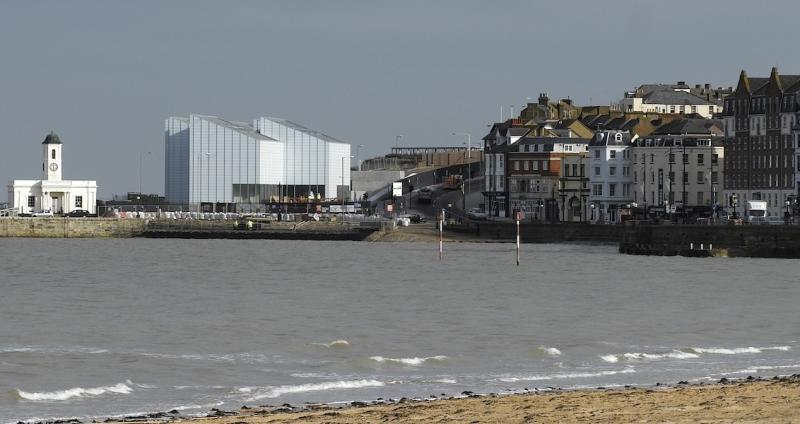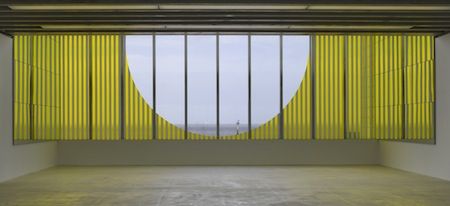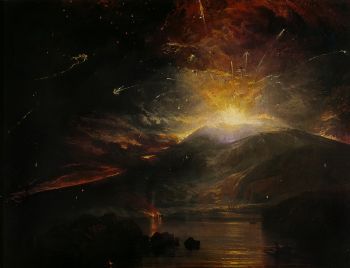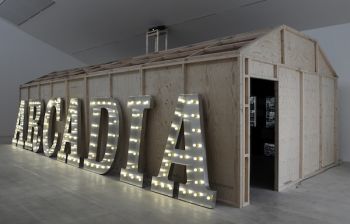Revealed, Turner Contemporary | reviews, news & interviews
Revealed, Turner Contemporary
Revealed, Turner Contemporary
An exhibition too modest to attract the hordes to Margate's new seafront gallery

The opening of Turner Contemporary is being heralded as one of the most important cultural events of the year. Described as "a national and international venue in the regions" the gallery, it is hoped, will attract visitors from London and abroad and transform Margate’s flagging fortunes by stimulating new businesses such as commercial galleries, as well as cafés, restaurants and bars.
I hope they are right, but the opening exhibition is such a low-key affair that I can’t imagine visitors flocking to see it. Regeneration is clearly the name of the game, though. The train passes by the ruins of the rollercoaster that once attracted holiday makers to Dreamland, one of Britain’s first amusement parks. After years of neglect, the park is currently being renovated for a planned re-opening in 2013 as a period piece – escapism retro-style.
The weather on my visit was perfect; the horizon dissolved in a haze of bright sunlight and the water was like a mill pond. Along the seafront the locals were busily sprucing up shabby arcades, shops and public toilets as though trying to awaken the place from a deep snooze. But after decades of decline, it will take more than a coat of paint to turn empty premises back into viable businesses – which is where the gallery comes in.

You can see David Chipperfield’s building from the station, but it is not very inviting. Consisting of three boxes clad in etched glass whose blue tinge nearly matches the sky, it seems to turn its back on the brick buildings of the old town, as if repudiating the past. It looks like a processing plant and, if the locals ever decide to give it a nickname, it might well be “the shed” or “fish factory”.
Built on the site of a boarding house where Turner used to stay, the gallery is intended as a celebration of the great painter’s relationship with the area, which inspired him to produce a hundred pictures ranging from sketches to full-blown oils. Waves Breaking on a Lee Shore at Margate (1840) is a tempestuous swirl of golden light that contrasts with the darkly gathering clouds and churning waves that threaten to capsize a listing ship. Turner loved the light and ever changing weather of this north-facing coast, declaring that "the skies over Thanet are the loveliest in all Europe".
Turner declared that "the skies over Thanet are the loveliest in all Europe"
Another attraction was his landlady, Mrs Boothe; when her husband died, he began calling himself Mr Boothe and, during his last five years, shared a house with her in Chelsea. On display are some old photographs of the guesthouse and a pub tray salvaged from the demolished Ship Inn painted to resemble a blue plaque that reads "1775-1851 JMW Turner lived near here".
After the sterile exterior, the foyer is surprisingly welcoming. Over the reception desk hangs a line drawing of a book in pink neon by Michael Craig Martin; the turning pages are like an invitation to embark on a metaphorical journey. Dominating the space is a huge window overlooking the sea. Framing the spectacular view are vertical strips of yellow and grey acrylic attached to the window by Daniel Buren around a circle of clear glass.
Through association, the circle reads as the sun and the yellow stripes as its rays; on either side, large mirrors reflect the light back and forth, intensifying the vibrancy and creating the atmosphere of a shrine for sun worship. The theme continues up the stairs. "The sun is God" were Turner’s last words. Douglas Gordon has inscribed them on the rises along with modifications that produce "the son is bad","the sun is good","the sun is bad" and so on, until he arrives at "God is the sun".
 Why are none of Turner’s Margate pictures included in the opening exhibition, though? We’ll have to wait until next January to see his seascapes in the exhibition Turner and the Elements. Meanwhile, we have The Eruption of the Souffrier Mountains, 1815 (pictured right). A volcano on the Island of St Vincent spews white-hot lava bombs into the night sky and, smothering the landscape in flaming rivers of molten rock, turns it into an apocalyptic vision of hell. Turner didn’t witness the event himself, but relied on a sketch made at the scene by Hugh Keane; this explains why, for all its melodrama, the picture lacks the immediacy of Waves Breaking... It may conjure the awesome power of nature, but misses the spontaneity of being there – or here.
Why are none of Turner’s Margate pictures included in the opening exhibition, though? We’ll have to wait until next January to see his seascapes in the exhibition Turner and the Elements. Meanwhile, we have The Eruption of the Souffrier Mountains, 1815 (pictured right). A volcano on the Island of St Vincent spews white-hot lava bombs into the night sky and, smothering the landscape in flaming rivers of molten rock, turns it into an apocalyptic vision of hell. Turner didn’t witness the event himself, but relied on a sketch made at the scene by Hugh Keane; this explains why, for all its melodrama, the picture lacks the immediacy of Waves Breaking... It may conjure the awesome power of nature, but misses the spontaneity of being there – or here.
With windows way too high to see through, the spartan galleries on the second floor could be almost anywhere. This forces you to focus on the art, but the work – by one British artist and three from America – doesn’t live up to the challenge. Why is Tracey Emin, Margate’s most famous daughter, not included? Installed over the door of the harbour master’s office nearby, her pink-neon sign I never stopped loving you is almost invisible in daylight.
Emin would have been a huge draw, but few will board the train to see the work of unknown Americans like Russell Crotty; a keen surfer, his cartoon-like sketches convey the exhilaration of riding a huge breaker. The waves along this shore are mostly gentle, so Crotty relies on fantasy for his sketch of a surfer speeding into the shallow bay on a cresting giant. Coastal walks provide the impetus for drawings on hanging globes. In Walking Towards Dreamland, the cliffs of Botany Bay provide a screen onto which Crotty has scrawled banal observations such as "The tides fairly high, must use the bluff... The breakfast at the Walpole Bay Hotel has kept me going; eggs, bacon, tomato, toast, sautéed mushrooms. Yum." Why was he flown over to follow the Kent coastline, when British artists Richard Long and Hamish Fulton have spent decades walking and recording their impressions with infinitely more grace and intelligence?
 Projected on the wall of Ellen Harvey’s room is a video of the sea off Coney Island, another resort that has seen better days. Spelling out the word "Arcadia", white fun-fair lights conjure an unspoiled paradise, but the huge letter forms are propped against a shed as though awaiting installation. The shed (pictured above left) is meant to evoke the gallery that Turner opened in his Harley Street home, but is lined with engravings on Perspex of the Margate seafront. Resembling linocuts, the clumsily old-fashioned images suggest that the town is stuck in the past.
Projected on the wall of Ellen Harvey’s room is a video of the sea off Coney Island, another resort that has seen better days. Spelling out the word "Arcadia", white fun-fair lights conjure an unspoiled paradise, but the huge letter forms are propped against a shed as though awaiting installation. The shed (pictured above left) is meant to evoke the gallery that Turner opened in his Harley Street home, but is lined with engravings on Perspex of the Margate seafront. Resembling linocuts, the clumsily old-fashioned images suggest that the town is stuck in the past.
Harvey’s installation sums up the situation rather well. Hopes of economic regeneration are being pinned on two forms of escapism – a revamped amusement park and a spanking new art gallery. It may be an uphill struggle, though. Lacking a collection of its own, the gallery feels like an empty shell; it will need the boundless enthusiasm of local people, as well as hundreds of visitors, to bring it to life. And while the opening celebrations may create a pool of goodwill, the opening exhibition is far too modest to attract the hordes. I doubt if Turner Contemporary will put Margate on the cultural map as the Guggenheim did with Bilbao.
- Revealed at Turner Contemporary from 16 April to 4 September
 Find Turner on Amazon
Find Turner on Amazon
Explore topics
Share this article
The future of Arts Journalism
You can stop theartsdesk.com closing!
We urgently need financing to survive. Our fundraising drive has thus far raised £49,000 but we need to reach £100,000 or we will be forced to close. Please contribute here: https://gofund.me/c3f6033d
And if you can forward this information to anyone who might assist, we’d be grateful.

Subscribe to theartsdesk.com
Thank you for continuing to read our work on theartsdesk.com. For unlimited access to every article in its entirety, including our archive of more than 15,000 pieces, we're asking for £5 per month or £40 per year. We feel it's a very good deal, and hope you do too.
To take a subscription now simply click here.
And if you're looking for that extra gift for a friend or family member, why not treat them to a theartsdesk.com gift subscription?
more Visual arts
 'We are bowled over!' Thank you for your messages of love and support
Much-appreciated words of commendation from readers and the cultural community
'We are bowled over!' Thank you for your messages of love and support
Much-appreciated words of commendation from readers and the cultural community
 Folkestone Triennial 2025 - landscape, seascape, art lovers' escape
Locally rooted festival brings home many but not all global concerns
Folkestone Triennial 2025 - landscape, seascape, art lovers' escape
Locally rooted festival brings home many but not all global concerns
 Sir Brian Clarke (1953-2025) - a personal tribute
Remembering an artist with a gift for the transcendent
Sir Brian Clarke (1953-2025) - a personal tribute
Remembering an artist with a gift for the transcendent
 Emily Kam Kngwarray, Tate Modern review - glimpses of another world
Pictures that are an affirmation of belonging
Emily Kam Kngwarray, Tate Modern review - glimpses of another world
Pictures that are an affirmation of belonging
 Kiefer / Van Gogh, Royal Academy review - a pairing of opposites
Small scale intensity meets large scale melodrama
Kiefer / Van Gogh, Royal Academy review - a pairing of opposites
Small scale intensity meets large scale melodrama
 Jenny Saville: The Anatomy of Painting, National Portrait Gallery review - a protégé losing her way
A brilliant painter in search of a worthwhile subject
Jenny Saville: The Anatomy of Painting, National Portrait Gallery review - a protégé losing her way
A brilliant painter in search of a worthwhile subject
 Abstract Erotic, Courtauld Gallery review - sculpture that is sensuous, funny and subversive
Testing the boundaries of good taste, and winning
Abstract Erotic, Courtauld Gallery review - sculpture that is sensuous, funny and subversive
Testing the boundaries of good taste, and winning
 Edward Burra, Tate Britain review - watercolour made mainstream
Social satire with a nasty bite
Edward Burra, Tate Britain review - watercolour made mainstream
Social satire with a nasty bite
 Ithell Colquhoun, Tate Britain review - revelations of a weird and wonderful world
Emanations from the unconscious
Ithell Colquhoun, Tate Britain review - revelations of a weird and wonderful world
Emanations from the unconscious
 Rachel Jones: Gated Canyons, Dulwich Picture Gallery review - teeth with a real bite
Mouths have never looked so good
Rachel Jones: Gated Canyons, Dulwich Picture Gallery review - teeth with a real bite
Mouths have never looked so good
 Yoshitomo Nara, Hayward Gallery review - sickeningly cute kids
How to make millions out of kitsch
Yoshitomo Nara, Hayward Gallery review - sickeningly cute kids
How to make millions out of kitsch
 Hamad Butt: Apprehensions, Whitechapel Gallery review - cool, calm and potentially lethal
The YBA who didn’t have time to become a household name
Hamad Butt: Apprehensions, Whitechapel Gallery review - cool, calm and potentially lethal
The YBA who didn’t have time to become a household name

Add comment